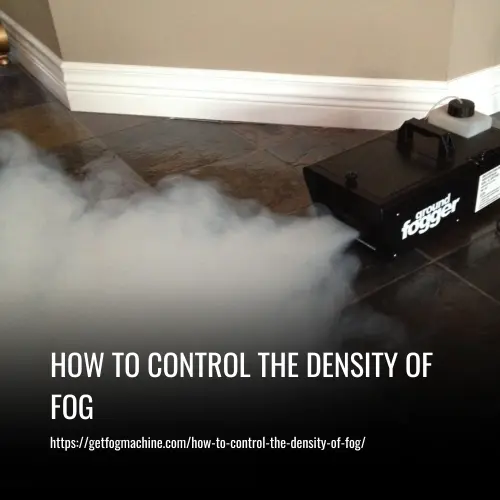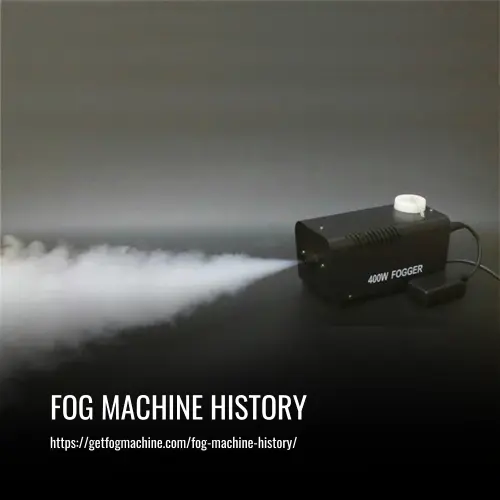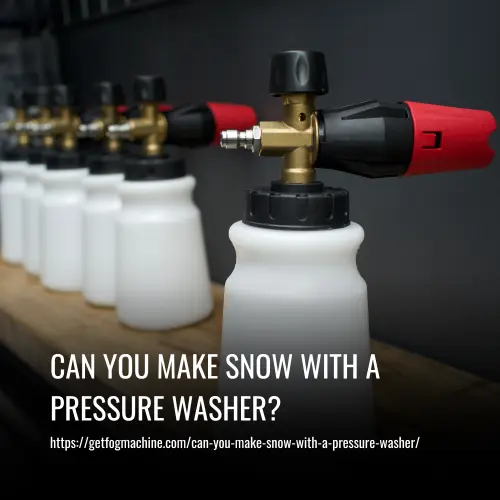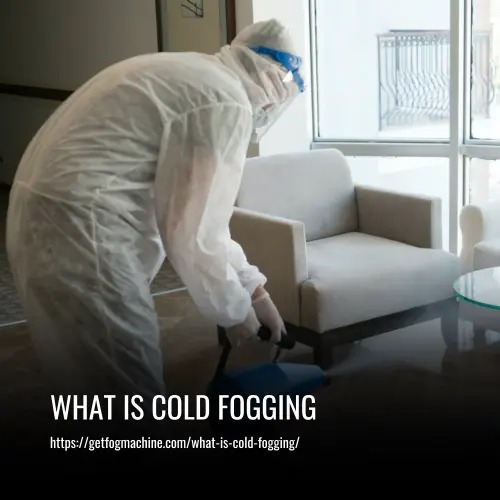How To Control The Density Of Fog
This post contains affiliate links. As an Amazon Associate, we earn from qualifying purchases.
To control the density of fog, there are a few key factors to consider. First, you can adjust the amount of fog fluid used in the fog machine. More fluid will create denser fog, while less fluid will result in thinner fog. Additionally, the distance between the fog machine and the desired area of coverage can affect the density. The closer the machine is placed, the denser the fog will be.
Another factor to consider is the evaporation rate of the fog fluid. Slower evaporation will lead to a denser fog, while faster evaporation will create thinner fog. Finally, using other props or devices such as haze machines or volumetric lighting can also influence the density of the fog. Experimenting with these variables will enable you to achieve the desired density for your specific application.

What Is Fog Density
Fog density refers to the intensity or thickness of the fog produced by a fog machine. It describes how much the fog fills the room and can greatly impact the visual and atmospheric effects of the fog. There are typically three levels of fog density: thin, medium, and thick.
Thin fog is dispersed and less concentrated, creating a subtle and ethereal ambiance. Medium fog lies in between, providing a balance between visibility and density. Thick fog, on the other hand, is heavy and concentrated, creating a more dramatic and immersive effect.
The density setting you choose depends on the desired outcome of your fog effect. Factors such as room size, ambient temperature, humidity, and the fog machine’s settings can all influence the fog’s density. It’s important to consider these variables to achieve the desired fog effect for any event.
Factors that Affect Fog Density
The density of fog created by a fog machine can be influenced by several factors. Understanding these factors is essential in controlling the density of fog to achieve the desired effect. Here are some key factors that can affect fog density:
1. Type of Fog Machine
Different types of fog generators employ various methods, resulting in fog with different densities. Whether the machine uses a heating element, dry ice, or CO2 will impact the density of the fog produced.
2. Size and Power of the Fog Machine
The size and power of the fog machine can also play a role in fog density. Larger and more powerful machines tend to produce thicker, more concentrated fog.
3. Area Size
The size of the area where the fog machine is operated can affect fog density as well. Fog may appear thicker in smaller spaces due to higher concentration, while it may appear thinner and more diffuse in larger areas.
4. Temperature and Humidity
Temperature and humidity conditions also influence fog density. Cool and humid environments favor fog formation and densification, resulting in thicker fog. In warm and dry environments, the fog may be thinner and less dense.
High Density Fog
High density fog requires a powerful fog machine with a large output capacity. To achieve the desired density, it is recommended to use a specific type of fog fluid designed for producing thick and dense fog. Factors such as temperature, humidity, and the size of the area where the fog machine is being used also play a role in determining the fog density.
In areas with high humidity and smaller spaces, the fog will generally be thicker, whereas in larger areas with drier climates, the fog density may be lower. It’s important to note that creating very high density fog can be challenging and may require some experimentation to achieve the desired effect.
To maintain the fog machine’s functionality, regular cleaning and maintenance are necessary, and the fluid tank may need to be refilled more frequently. However, the effort is worth it as high density fog can create a dramatic and immersive atmosphere for various events and environments.
Is High Density Fog Fluid Worth It
The worthiness of high density fog fluid depends on your specific needs and preferences. This type of fog liquid is designed to generate thick, dense fog, making it ideal for stage lighting, special effects, and other settings that require an immersive fog environment.
If you want to create a dramatic and fully enveloping fog effect, high density fog machine fluid can be a worthwhile choice. When paired with a powerful fog machine or used in smaller spaces, it can deliver an impressive result. However, not every situation calls for high density fog fluid. If you are aiming for a subtle and ambient fog effect, a thinner and less dense fog fluid might suffice.
How to Adjust Fog Density
To create the desired fog effect for your event, it is essential to control the density of the fog produced by a fog machine. Whether you aim for a subtle, ethereal ambiance or a dense, immersive impact, here are the steps to adjust fog density effectively:
1. Choose the right fog generator
Consider the size of the area where the fog machine will be used and the desired level of fog density. Smaller, lower-powered machines are suitable for thin, diffuse fog, while larger, more powerful machines are better for thick, dense fog.
2. Select the appropriate fog fluid
Different types of fog fluid can create fog with varying densities. Some types are designed to produce dense, thick fog, while others create thin, misty fog. Choose the fog fluid that matches your desired fog density.
3. Consider temperature and humidity
The environment’s temperature and humidity can affect fog density. Warmer, drier settings tend to result in thinner, more diffuse fog, while cooler, more humid environments produce denser fog. Adjust the fog machine’s density settings accordingly.
4. Experiment with output settings
Most fog machines have adjustable output settings that allow you to control the amount of fog produced. Try different settings to see how they alter fog density. Increasing the output can create thicker, concentrated fog while decreasing it produces thinner, more diffuse fog.
5. Fine-tune as needed
Once you find a general density level that you like, make minor adjustments to the output settings or the type of fog fluid used to further fine-tune the fog density. With practice and experimentation, you can achieve the ideal fog density for any situation.
FAQs
Fog fluids come in various forms, each with unique qualities that can affect the fog’s density. Water-based fog fluids create light, diffuse fog, while oil-based fluids produce heavier, more concentrated fog. Additives such as glycol or glycerin can be used to create a thicker fog. Some fog fluids may also contain perfumes or fragrances for added depth and realism. It’s important to select the appropriate fog fluid to achieve the desired density for your fog machine.
To produce low-lying fog, choose a fog machine specifically designed for this purpose or consider a ground fogger or a cold fog machine. Use fog fluids that are formulated for low-lying fog. Factors like temperature and humidity can also impact the fog’s density, so consider the environment when setting up the machine. Experiment with the output settings to find the right balance between fog density and desired effect.
Haze machines produce a light, dispersed mist that is thinner and less dense than traditional fog. This fog can linger in the air for longer periods, making it ideal for creating a soft, ambient effect or highlighting specific light sources. Airborne fog, also known as mist or haze, is typically less dense than traditional fog and is often used to create subtle, atmospheric effects in stage lighting, musical performances, photography, and cinema.
To make fog last longer, use the right water-to-dry-ice ratio when producing fog effects. The ideal ratio is about 1/2 gallon of hot water per pound of dry ice. This will help maximize the fog’s longevity.
Thickening agents such as glycerin or glycol can be added to fog fluid to create a denser fog. Increasing the amount of these agents in the mixture will result in a thicker fog.
Fog fluids primarily consist of an active ingredient, which can be propylene glycol, triethylene glycol, glycerin, or a combination of these, along with deionized water. The choice of active ingredient affects the fog’s density, and it’s important to use a fog machine that is compatible with the chosen fluid.
Conclusion
Controlling the density of fog is crucial in creating the desired atmospheric effects. By understanding the factors that influence fog density and employing the right techniques and equipment, designers and event planners can achieve stunning visual effects and enhance the overall ambiance of a space.
Using specialized fog fluid and selecting the appropriate fog machine can help achieve the desired density. Factors such as fog distance, evaporation rate, and volume properties should be considered when attempting to control fog density. Designers should also take into account the lighting sources and the desired visual reference in order to achieve the desired fog density distribution.






